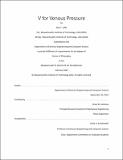V for Venous Pressure
Author(s)
Jaffe, Alex T.
DownloadThesis PDF (55.26Mb)
Advisor
Anthony, Brian W.
Terms of use
Metadata
Show full item recordAbstract
Cardiovascular disease is the world’s leading cause of death. Striving to decrease cardiovascular related deaths and improve quality of life, medical treatments have advanced, and society has become better informed on leading a healthy lifestyle. In parallel, our ability to monitor patients with cardiovascular disease has progressed substantially. Yet, many measurements still require invasive means for clinically acceptable accuracy. Medical ultrasound imaging noninvasively provides images of the heart and major blood vessels in real-time while emitting no harmful radiation and costing relatively little to operate. In this thesis, force-coupled ultrasound imaging techniques are developed to create accurate and noninvasive methods to measure central venous pressure and central arterial pressure.
Force-coupled ultrasound imaging of blood vessels is a process which outputs ultrasound images containing at least one segmented blood vessel of interest and assigns a force to each image. Data is acquired with a force-coupled ultrasound probe – an ultrasound probe which measures force applied. To analyze, three data processing steps proceed automatically in order: (1) ultrasound images are synchronized with force data, (2) the blood vessel of interest is detected within the force-coupled ultrasound images, and (3) the blood vessel is segmented in each relevant image. Central arterial pressure is estimated calibration-free through force-coupled ultrasound imaging of the carotid artery combined with inverse finite element modeling [formula]. Collapse force – the force necessary to completely occlude a vein in a particular anatomical location – of the internal jugular vein is shown to predict central venous pressure with high accuracy at MIT [formula] with a limited range of venous pressures with healthy subjects and at Massachusetts General Hospital [formula] with a more vast range of venous pressures and heart failure intensive care unit patients. Additionally, central arterial and central venous pressure are simultaneously estimated through force-coupled ultrasound imaging and inverse finite element modeling of the carotid artery and internal jugular vein in the same image ultrasound viewing window.
The proposed force-coupled ultrasound imaging techniques are well-suited to improve how central venous pressure is measured in patients with decompensated heart failure. These methods also have potential to provide a more accurate and facile central venous pressure measurement for compensated and early stage heart failure and a more informed central arterial pressure measurement for cardiovascular disease in general.
Date issued
2023-02Department
Massachusetts Institute of Technology. Department of Electrical Engineering and Computer SciencePublisher
Massachusetts Institute of Technology